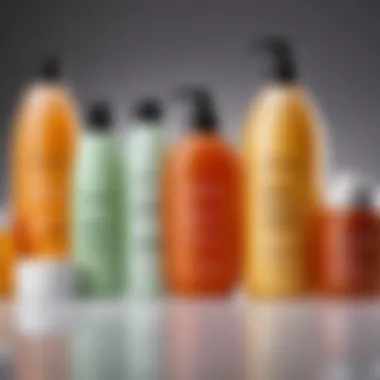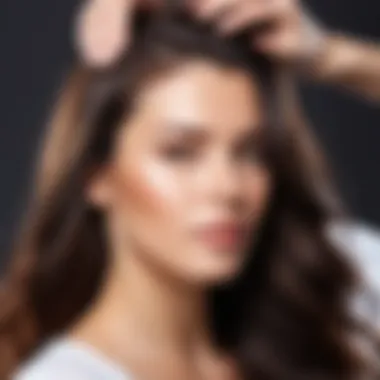Ultimate Guide to Restoring Hair After Keratin Treatments


Intro
Keratin straightening can provide beautiful, sleek hair but often comes with its drawbacks. The chemical process involved can lead to significant damage, necessitating a comprehensive recovery plan. Understanding how to effectively restore hair after treatment is crucial not only for aesthetics but also for the long-term health of your hair.
In this guide, we will explore various aspects of hair restoration post-keratin treatment. We will highlight the common challenges faced by individuals undergoing this procedure, outline essential aftercare routines, and provide recommendations for effective products tailored to different hair types and conditions. This information is based on both user experiences and professional advice, ensuring a balanced perspective on the restoration journey.
Популярные акции и предложения
After undergoing keratin straightening, many individuals feel the urge to invest in high-quality hair care products. Fortunately, various cosmetic brands often run promotions and seasonal sales. Staying informed about these offers can help you save money while obtaining the right products for restoring your hair.
- Обзор текущих скидок на косметические бренды
Many brands offer discounts on shampoos, conditioners, and masks designed specifically for chemically-treated hair. Keeping an eye on websites and newsletters from brands you trust can lead to valuable savings. - Сезонные распродажи и специальные предложения
Occasional sales, especially during holidays or end-of-season events, can result in significant reductions on premium hair care products. Make sure to check multiple retailers for the best prices.
Рекомендации по выбору косметики
Choosing the right products after keratin treatments is essential for effective recovery. Not all products are created equal; it is vital to select those that complement your specific hair type.
- Как выбрать косметические средства по типу кожи
First, determine your hair type – whether straight, wavy, curly, or coily. Each type has different needs. Products tailored for dry, frizzy, or color-treated hair may be beneficial after keratin treatments to restore moisture and combat damage. - Советы по выбору косметики для разных возрастных групп
Hair care products are also formulated with different age groups in mind. For younger individuals, lightweight formulations might be sufficient, while more mature hair may benefit from richer, more intensive treatments to address issues like thinning or dryness.
Remember: Always read product labels and opt for sulfate-free, paraben-free options whenever possible to ensure minimal irritation and maximum effectiveness.
As you navigate the intricate path of hair restoration post-keratin treatment, the information outlined here will serve as a bedrock for what comes next. Stay tuned for more detailed insights on post-treatment care.
Preamble to Keratin Straightening
In the realm of hair care, keratin straightening has emerged as a popular technique. This procedure promises smooth, frizz-free hair for an extended duration. However, it is essential to grasp the entirety of the process and its implications for hair health. Understanding "Introduction to Keratin Straightening" lays the groundwork for appreciating the significance of effective restoration strategies after treatment.
Overview of the Procedure
Keratin straightening involves the application of a solution containing keratin to the hair. This procedure is often performed in salons by trained professionals. The application is then usually followed by heat treatment, which locks in the keratin and alters the hair's structure. The result is straight, shiny hair that is easier to manage.
However, the chemical formulas used can vary from one product to another, leading to differing effects on hair. Therefore, it is crucial to select a reputable salon and stylist who uses products known for their safety and efficacy. The procedure itself typically takes several hours, depending on the length and thickness of the hair.
Benefits and Risks Involved
The benefits of keratin straightening are palpable for many. Key advantages include:
- Reduced Frizz: Many clients enjoy smooth hair that remains manageable in high humidity.
- Time-Saving: Hair styling can become significantly easier and faster post-treatment, reducing daily preparation time.
- Longevity: Results usually last several months, extending the period between salon visits.
Nonetheless, there are risks involved. The heat and chemicals can compromise the hair's integrity, leading to potential damage over time. Some may also experience allergic reactions to the products. Understanding these risks is essential for anyone considering the treatment.
Understanding Hair Structure
To appreciate the impact of keratin straightening, one must understand hair structure itself. Hair comprises three main layers: the cuticle, cortex, and medulla. The cuticle is the outer layer, providing protection. The cortex contains keratin and contributes to the hair's strength and elasticity. The medulla is the central part and is often absent in finer hair types.
When keratin treatment is applied, the keratin penetrates the cortex. This process temporarily alters the natural structure, leading to smoother strands. However, continuous exposure to chemicals and heat from the treatment may lead to damage. For this reason, restoration after keratin straightening is essential.
Immediate Effects of Keratin Treatment
Understanding the immediate effects of keratin treatment is crucial for anyone considering or recovering from the procedure. It provides clarity on what to expect right after the treatment and sets the stage for further care and restoration. Post-treatment effects can serve as indicators of how your hair may respond to the chemicals involved, influencing your choices in aftercare and restoring practices.
Visual Changes in Hair
After keratin straightening, one of the most noticeable changes is the visual aspect of hair. The treatment generally results in a sleek and shiny appearance that many find appealing. Hair appears smoother and often has a more polished look. However, the glossy effect can sometimes mask underlying issues. It's essential to recognize that this immediate enhancement can be an illusion, as the hair may still be experiencing stress from the treatment.


Many people report a significant reduction in frizz and curl, which can lead to a false sense of security regarding hair health. The initial visual success might mean that one overlooks necessary precautions, leading to future damage if not managed properly. Therefore, it’s important to evaluate the condition of the hair closer. Checking for any signs of damage usually requires careful observation, as the outer layer may look fine while the hair's internal structure is still compromised. Making note of this can help in planning for effective restoration techniques later.
Feelings of Damage and Fragility
Along with the visual changes, many individuals report feelings of damage and fragility after keratin treatments. It is not uncommon to experience sensations of dryness or brittleness. Many describe their hair as feeling less substantial or even gummy, which indicates a level of distress due to the chemicals used. While keratin is intended to strengthen hair, the immediate aftermath can bring about a paradox where it feels weaker.
These sensations should not be overlooked. They can signify that your hair has been burdened with excessive heat or products applied during the treatment process. It's crucial to approach the immediate post-treatment period delicately, as it lays the groundwork for successful restoration. Regular touchpoints such as tactile assessments of hair texture and visual inspections can facilitate early intervention if fragility becomes apparent.
Key Insight: Recognizing the feelings of damage can guide users in assessing hair health accurately, leading to more tailored and effective restoration strategies.
Signs of Damaged Hair Post-Treatment
Understanding the signs of damaged hair after keratin straightening is crucial for effective restoration. This section provides insight into the indicators that signify hair has sustained damage, guiding readers on how to assess their hair's condition. Recognizing these signs can lead to timely interventions, preventing further deterioration and facilitating recovery.
Identifying Signs of Breakage
Breakage is a common consequence of keratin treatments. Common signs include:
- Short, broken strands, often scattered among healthy hair.
- Split ends that appear frayed and excessive.
- Difficulty in styling, as broken hair may not hold shapes or curls.
Noticing these indications is essential for anyone recovering from keratin treatment. It reflects the urgency of a tailored care approach. In many cases, breakage results from weakened hair elasticity and moisture loss. Addressing these symptoms early on can significantly improve the hair’s overall integrity.
Tools like a wide-toothed comb can minimize damage when detangling, while gentle handling during styling can reduce stress on brittle hair.
Assessing Texture Changes
Texture changes may reveal the extent of damage inflicted by the treatment. Typical signs arise as follows:
- Hair feels rough or brittle instead of smooth and shiny.
- Unexpected changes in wave patterns or frizziness.
- A noticeable lack of volume or body, leading to hair looking limp.
These texture alterations signal that the hair’s natural moisture balance has been disrupted. Often, damaged hair loses its ability to retain moisture, resulting in a coarse feel.
Observation of these texture changes is important because it influences the choice of treatments. Users may require richer, more hydrating products to restore their hair's smoothness and health.
"Assessing hair texture is not just a cosmetic concern; it represents the underlying health of the hair. Recognizing this is a vital step in restoration."
In summary, identifying signs of breakage and assessing texture changes are essential parts of understanding the impact of keratin straightening. Each signal can guide appropriate actions, enabling individuals to implement effective restoration strategies.
Essential Aftercare Practices
After undergoing keratin straightening, effective aftercare practices play a crucial role in restoring and maintaining hair health. The treatment has potential ramifications that can alter the natural state of hair, making proper aftercare essential to mitigate any damage. By addressing how to care for hair, individuals can enhance not only the longevity of the treatment but also the overall condition of their hair over time.
Suitable Shampoo and Conditioner Selection
Choosing the right shampoo and conditioner is fundamental in the aftercare routine. Opt for sulfate-free products. Sulfates can strip the hair of essential oils, exacerbating dryness and damage. Look for formulas that are nourishing and hydrating, ideally containing ingredients like argan oil or shea butter that provide moisture and protect the hair structure.
When selecting a conditioner, focus on those specifically designed for chemically treated hair. These conditioners are formulated to restore balance and hydration. Regular conditioning aids in maintaining the moisture content, which is often compromised after keratin treatments.
Optimal Washing Frequency
The frequency of washing hair post-treatment should be approached with caution. It is advisable to limit washing to two or three times a week. Overwashing can lead to brittleness and dryness. During the initial week after the treatment, it is best to avoid washing hair entirely to allow the keratin to properly bond with the hair strands.
When washing, utilize lukewarm water instead of hot, as hot water can cause the cuticle to open, leading to further damage. After washing, apply conditioner thoroughly and ensure it is rinsed out effectively, as residue can lead to buildup and potential harm to the hair.


Avoiding Heat Damage
Heat tools pose a significant risk to the integrity of hair following keratin treatments. It is imperative to minimize the use of blow dryers, flat irons, and curling wands. Excessive heat can reverse the benefits of the keratin treatment and cause additional damage. If heat styling is necessary, use it sparingly and always apply a heat protectant beforehand. Look for products that specifically mention protection for chemically-treated hair.
In summary, following these essential aftercare practices can significantly improve hair recovery and health after keratin straightening. Adopting a mindful approach to hair care will lead to better outcomes, prolong the results of the treatment, and contribute to the overall vitality of your hair.
Nourishing Treatments for Restoration
Deep Conditioning Masks
Deep conditioning masks offer intensive moisture and repair capabilities. These products penetrate the hair shaft more deeply than regular conditioners. They are typically rich in ingredients like shea butter, argan oil, and various proteins designed to rebuild strength. Using a deep conditioning mask can improve elasticity and reduce breakage, making it an excellent choice after a keratin treatment.
When selecting a deep conditioning mask, look for ingredients known for their moisturizing properties. Here are some key benefits:
- Enhanced Moisture Retention: The masks help seal in moisture, combating dryness.
- Improved Hair Texture: Regular use can lead to smoother and softer hair.
- Stronger Hair Structure: Protein-rich masks can help strengthen the hair, reducing brittleness.
To apply, simply distribute the mask evenly through damp hair, focusing on the ends. The directions usually suggest leaving it on for a period of time before rinsing thoroughly.
Leave-In Conditioners and Oils
Leave-in conditioners and oils play a pivotal role in maintaining hair hydration. Unlike regular conditioners that rinse out, leave-in products remain on the hair to provide ongoing nourishment. This is particularly beneficial after keratin treatments because they can continue to protect and hydrate throughout the day.
These products often contain oils such as jojoba, coconut, or argan oil, which can help with:
- Ongoing Moisture: Keeps hair hydrated without weighing it down.
- Frizz Control: Oils help smooth the outer layer of the hair, reducing frizz.
- Enhanced Shine: Provides a natural gloss that makes hair look healthier.
For best results, apply a small amount to clean, damp hair before styling. A little goes a long way, and focusing on the ends can help avoid greasiness.
"Choosing the right nourishing treatment can make a significant difference in the recovery process after keratin treatments."
Incorporating Professional Help
Engaging a professional stylist can significantly enhance the restoration efforts. They can recommend tailored hair products that align with specific hair types and conditions. These products, often not available over the counter, may contain specialized ingredients that target damage and aid in recovery. Moreover, stylists can inform clients about current trends in hair restoration techniques, ensuring that the approach taken is both effective and safe.
Deciding to consult with a professional also encompasses understanding the techniques and products used during salon treatments. This knowledge can empower clients by providing insight into future treatments and potential outcomes, establishing a clear line of communication regarding expectations and results.
Consult with professionals for personalized care plans that account for individual hair conditions and desires.
Consulting Professional Stylists
When seeking to restore hair, consulting professional stylists is not just a recommendation; it is an important step in the recovery process. Stylists have invested significant time in training and education, equipping them to assess various hair conditions accurately. They can conduct scalp examinations, recommend appropriate restorative treatments, and even perform necessary haircuts to remove excessively damaged hair.
Moreover, professional stylists often have access to high-quality hair products that are not available to general consumers. This includes deep conditioning treatments, protein treatments, and moisture-infused products that are essential for recovering hair health. By utilizing these professional-grade treatments, there is a higher chance that the restoration efforts will be more effective.
In addition to product recommendations, stylists can educate their clients about proper at-home care techniques. Stylists help clients understand how to maintain their hair between salon visits, ensuring that restoration continues consistently. More importantly, they can customize hair care regimens that fit individual lifestyles and preferences, which can lead to better outcomes.
Considerations for Treatments at Salons
When visiting a salon for hair restoration, several considerations should guide the decision-making process. Firstly, it is vital to communicate openly with the stylist about the extent of damage. Being honest about previous treatments and concerns can help the professional tailor their approach.
Consider the type of treatments being offered at the salon. Treatments like deep conditioning and specialized hair masks can provide immediate restorative effects, but understanding their ingredients and applications will lead to better results. Always inquire about the products used during treatments and their suitability for your specific hair type.
Another important consideration is the stylist’s experience. Opt for professionals who have specific experience with post-treatment care after keratin straightening. They should be able to provide testimonials or examples of past successful outcomes. Ensuring that the stylist is knowledgeable in the latest techniques will help maximize the effectiveness of restoration efforts.


Lifestyle Adjustments for Better Hair Health
Balanced Diet for Hair Restoration
A balanced diet is fundamental for hair restoration. Hair is primarily made up of protein, so including adequate amounts of protein-rich foods is essential. Here are some nutrients to consider:
- Protein: Chicken, fish, eggs, beans, and nuts are excellent sources.
- Omega-3 Fatty Acids: These fats found in fish like salmon, walnuts, and flaxseeds nourish hair and promote shine.
- Vitamins: Vitamins A, C, D, and E are critical for hair growth and health. Leafy greens, citrus fruits, and berries can help boost your vitamin intake.
- Minerals: Zinc and iron are vital for hair strength. You can find them in foods like lentils, lean meats, and whole grains.
To achieve the best results, aim for variety in your meals. This variety ensures that your body obtains all necessary nutrients to support hair regeneration and health.
Hydration's Role in Hair Care
Hydration is another significant aspect of hair health. Water makes up a large part of the hair structure, and staying hydrated can directly affect your hair's moisture levels.
- Drink plenty of water throughout the day. The recommendation is generally around eight 8-ounce glasses, but individual needs may vary.
- Include hydrating foods in your diet. Fruits like watermelon and cucumbers can contribute to your hydration needs.
Proper hydration can improve hair texture and make it less prone to breakage. Dehydrated hair can become dull and lifeless, making it essential to prioritize hydration in your daily routine.
Remember: Improving hair health is a journey that requires a comprehensive approach. Each adjustment you make counts towards the larger goal of restoring and maintaining your hair's vitality.
Long-Term Maintenance and Care
Long-term maintenance and care are crucial for individuals who have undergone keratin straightening treatments. Maintaining the health of treated hair requires consistent attention and a proactive approach. Neglecting proper care can lead to further damage, which can counteract the benefits of the initial treatment.
One key aspect of long-term care is adhering to a regular trim schedule. Trimming removes split ends and helps in maintaining the overall appearance. It is recommended to have a trim every six to eight weeks, but this can vary based on individual hair growth and condition. Regular trims ensure hair does not become overly damaged and promotes healthier growth.
Regular Trim Schedule
A regular trim schedule is essential to prevent accumulated damage in keratin-treated hair. Split ends can travel up the hair shaft, leading to frizz and breakage. In addition to improving appearance, trims can also enhance the effectiveness of nourishing treatments. Keeping scheduled appointments with a stylist is beneficial; they can assess the hair's health and make appropriate suggestions.
This routine also reminds individuals to stay engaged with their hair care journey. Monitoring progress after a keratin treatment can be motivating. How often you trim should also consider factors such as hair texture and environment exposure. For instance, if your hair is frequently exposed to heat tools, more frequent trims may be necessary.
Monitoring Hair Condition Over Time
Monitoring hair condition over time is equally important in ensuring long-term health. Analyze how the hair responds to various products and treatments. Look for signs of dryness, brittleness, or changes in texture. Pay attention to how manageable the hair is after washing and styling. Taking notes can help in tracking changes, which becomes helpful when consulting professionals.
Moreover, you may consider assessing hair's moisture levels regularly. Using tools, such as moisture meters, can provide insights into hydration. Consistent evaluation helps tailor hair care routines to meet specific needs. It reinforces the relationship between hair care and results achieved from treatments.
Maintaining a consistent approach to hair care is not just about improving aesthetics. It's about embracing a long-term commitment to health and vitality.
Epilogue
Recap of Effective Restoration Techniques
To provide clarity, here are the effective restoration techniques highlighted in this article:
- Use suitable shampoo and conditioner specifically designed for treated hair. These products help maintain moisture and prevent further damage.
- Incorporate deep conditioning masks regularly to nourish the hair, restoring essential nutrients lost during the keratin treatment.
- Consult professional stylists for personalized advice. They can recommend appropriate products and treatments based on individual hair conditions.
- Maintain a balanced diet rich in vitamins and minerals to support hair health from within. Nutrients such as biotin and Omega-3 fatty acids are particularly beneficial.
- Hydrate adequately, as water plays a key role in maintaining healthy hair.
This set of practices laid out can greatly assist in achieving desirable results in hair restoration.
Encouragement for Personalized Care Plans
It is important to remember that hair restoration is not a one-size-fits-all solution. Each person’s hair type, condition, and previous treatments vary greatly, which necessitates a personalized care plan. Consider the specific needs of your hair, taking into account factors like:
- The texture of your hair: Different textures may require unique products.
- The extent of damage: Assess how severely the treatment has affected your hair to determine the intensity of care needed.
- Lifestyle: A busy lifestyle may dictate simpler routines, while more time may allow for more extensive care.
Seeking guidance from professionals and listening to your hair can guide you toward an effective and tailored restoration strategy. This attention to detail can ultimately lead to restored vibrance and health in your hair.
"Customized care plans are key to effective restoration. Tailoring your approach based on unique hair needs enhances results and promotes long-term health."















